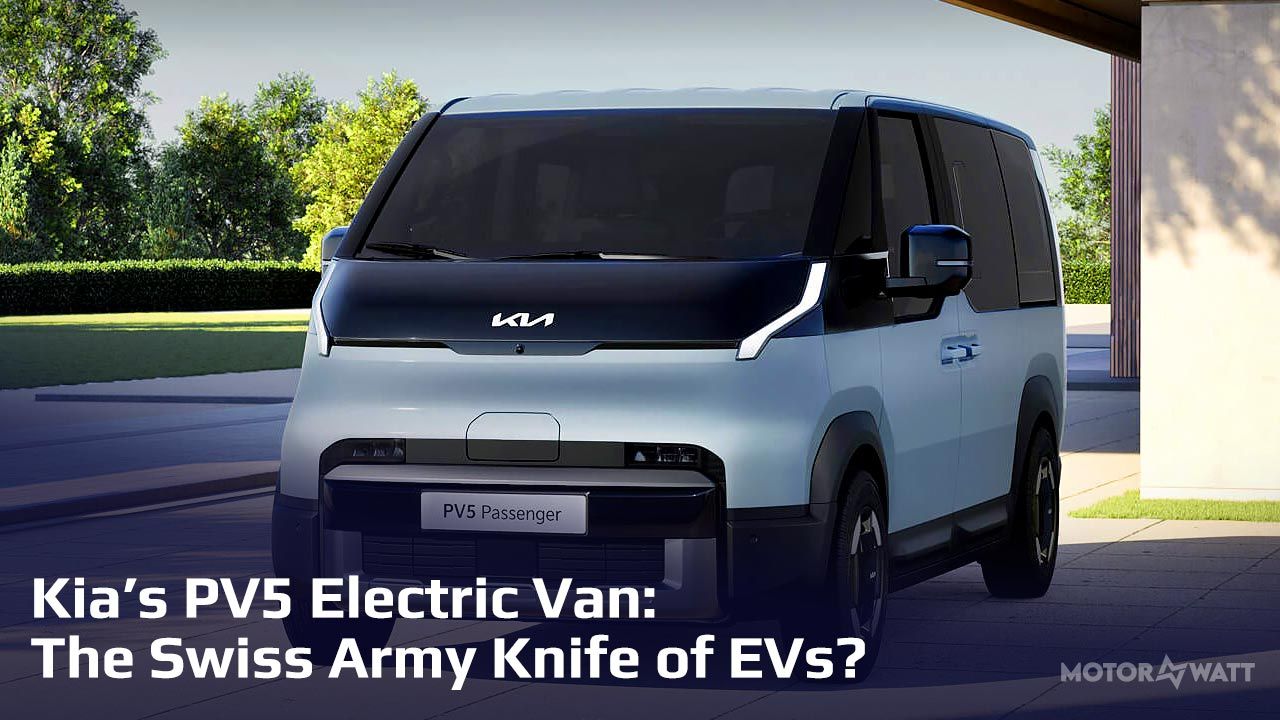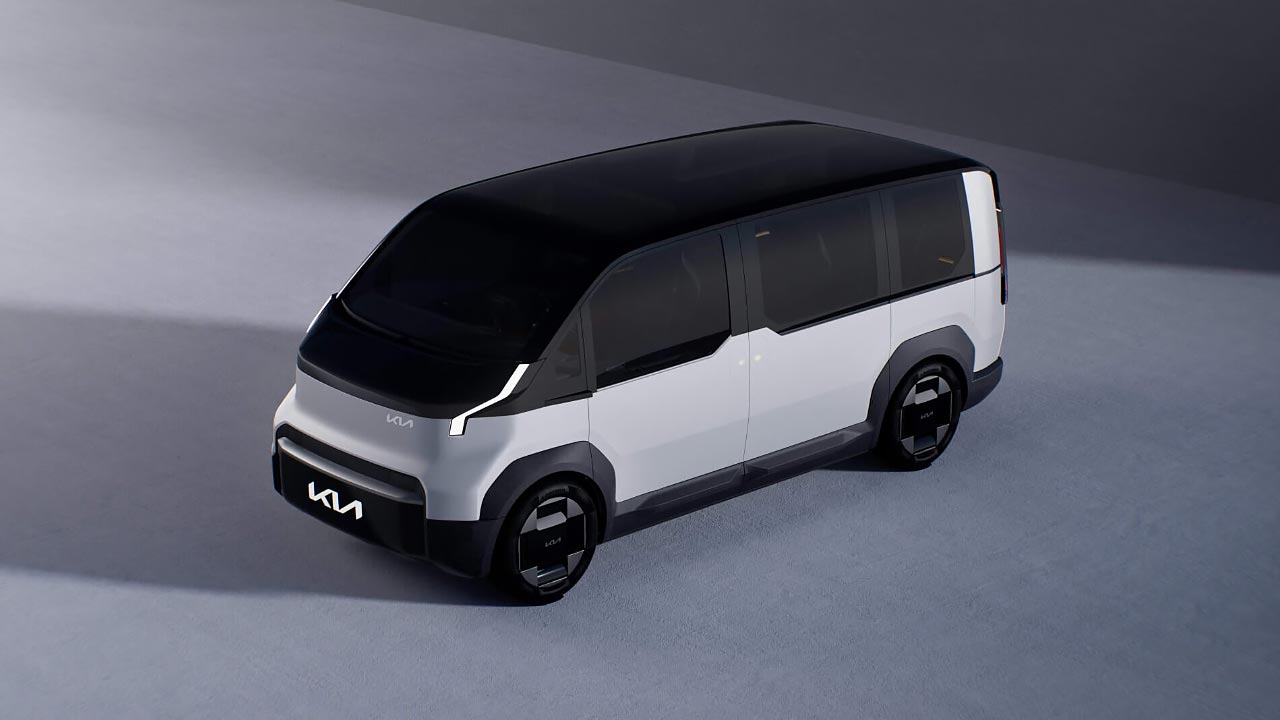Kia’s PV5 Electric Van: The Swiss Army Knife of EVs?
Share this article in Social Media:

The Kia PV5 is an electric van under Kia’s “Platform Beyond Vehicle” (PBV) lineup, featuring a modular design for customizable cargo and passenger configurations. Expected to offer a 200-mile range, fast charging, and a starting price below £40,000, the PV5 is poised to revolutionize urban logistics and fleet electrification.
What’s the Buzz About Kia’s PV5?
Kia’s got the EV world talking with the upcoming PV5, the first in its “Platform Beyond Vehicle” (PBV) lineup. This isn’t just another electric van—it’s a shape-shifting workhorse designed to swap roles on demand. Think cargo hauler by day, people mover by night, and maybe even a mobile coffee shop on weekends. With a boxy yet sleek design, sliding doors, and a flat-faced stance optimized for space, the PV5 could be the van that businesses didn’t realize they needed—until now.
PBV Strategy: The Modular Advantage
What sets the PV5 apart from traditional commercial EVs? It’s Kia’s modular approach, inspired by the skateboard platforms we’ve seen from Rivian and Canoo. The electric chassis remains standard, but the upper structure can be reconfigured. Need a refrigerated delivery van? Snap it on. Want to convert it into a rideshare vehicle? Switch it up. This Lego-like flexibility makes it an attractive choice for businesses looking to consolidate fleet costs without sacrificing functionality.

Expected to be revealed at Kia’s EV Day on February 24, 2025, the PV5 is part of a lineup that will include the larger PV7 and the compact PV1. Kia’s leaning on its partnership with Hyundai Mobis for the electric underpinnings, ensuring the platform is both scalable and efficient.
Kia PV5 Specs: What We Know So Far
While Kia is keeping some details under wraps, leaked specs give us a glimpse of what to expect:
- Battery & Range: Around 200 miles (320 km) WLTP—sufficient for last-mile deliveries and urban transport.
- Charging Speed: Industry sources hint at 80% charge in 30 minutes, meaning minimal downtime.
- Payload: Approximately 1,000 kg (2,200 lbs), making it a direct competitor to gas-powered work vans.
- Towing Capacity: Expected to exceed 1,500 kg (3,300 lbs) if a dual-motor version is offered.
- Interior & Tech: A minimalist digital dashboard with swappable storage and seating modules.
How Does the PV5 Compare to Rivals?
The commercial EV space isn’t empty—Kia is stepping into the ring with Ford’s E-Transit, Stellantis’ e-Ducato, and Volkswagen’s ID. Buzz Cargo. But here’s where the PV5 might have the edge:
- Price Advantage: Insiders suggest a base price below $50,500 {£40,000 or €47,000), significantly undercutting the Ford E-Transit’s $63,000 {£50,000 or €58,700).
- Customization: Unlike fixed-layout vans, the PV5 can be adapted for multiple roles, reducing fleet redundancy.
- Lower Operating Costs: With LFP (lithium iron phosphate) batteries, Kia avoids expensive cobalt, keeping costs down and longevity up.
Urban Readiness: Why Cities Love the PV5
Electric vans aren’t just a green alternative; they’re becoming a necessity. Cities like London’s ULEZ (Ultra Low Emission Zone) are penalizing diesel vans with daily charges of $16 {£12.50 or €15), making compliance a financial must. Governments worldwide are rolling out incentives for commercial EV adoption, and with fuel costs rising, businesses are crunching numbers and realizing EVs save serious cash over time.
The PV5 is positioned as the perfect fleet solution for:
- Last-mile delivery—DHL and UPS are reportedly eyeing it.
- Ride-sharing and shuttle services—modular seating makes it adaptable.
- Specialty businesses—mobile offices, pop-up retail, even food trucks.
What’s the Catch?
No EV launch is without concerns. Here are a few lingering questions:
- Is 200 miles enough? While it’s fine for city fleets, rural operators might struggle.
- Battery longevity? Hauling heavy loads daily could lead to faster degradation.
- Charging infrastructure? Cities are expanding their networks, but fast chargers are still scarce in some areas.
- Production bottlenecks? Lithium and nickel shortages could push back deliveries.
The Bigger Picture: Kia’s Bet on Commercial EVs
The PV5 isn’t just about selling another EV—it’s Kia’s entry into a massive market shift. Commercial vehicles account for 15% of global road emissions, yet only 2% of sales were electric in 2024. With e-commerce at an all-time high (over 200 billion parcels shipped in 2024), urban delivery demand is exploding.
Ford’s E-Transit sold 25,000 units last year, proving there’s demand—but supply isn’t keeping up. If Kia can scale production efficiently, the PV5 could become the go-to van for businesses ready to ditch diesel.
What to Expect at Kia’s EV Day
Mark February 24, 2025, on your calendar—Kia is expected to:
- Reveal final specs, pricing, and pre-order details.
- Confirm partnerships with major logistics and ride-sharing companies.
- Showcase different PV5 variants, including rumored “PV5 Work” and “PV5 Life” editions for tradespeople and camper enthusiasts.
Final Thoughts: Is the PV5 a Winner?
Kia’s PV5 might not have the longest range or the flashiest design, but its modularity, price point, and urban practicality make it one of the most exciting commercial EVs of 2025. If it delivers on cost savings and adaptability, we might soon see streets lined with PV5s in various forms—from delivery fleets to mobile cafés.
What do you think? Will the PV5 reshape urban transport, or is it just another contender in the crowded EV race?












